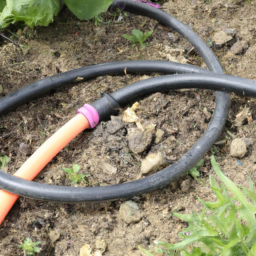How To Use A Soaker Hose in a Vegetable Garden
How To Use A Soaker Hose In A Vegetable Garden
It's no secret that the healthiest and most delicious vegetables come straight from your backyard, but one of the tricky things about growing veggies and herbs is ensuring they get enough water. A soaker hose is a great option to consider when tackling this specific problem. But there's more to using a soaker hose properly than one might think. From positioning it properly to being attentive to weather shifts, here is everything you need to know about using a soaker hose in a vegetable garden.
What is a Soaker Hose?
A soaker hose is a garden watering tool that slowly and evenly soaks and waters plants. It is made of recycled rubber or plastic that is porous enough to silently release a steady stream of water along the entire length of the hose. Soaker hoses are less expensive than automatic sprinkler systems and can be less time-consuming for the gardener.
Benefits of Installing a Soaker Hose
Soaker hoses are an efficient way to water vegetable gardens because they allow you to hand-water without having to stand by and monitor the hose. They provide a steady, slow water release so the water is thoroughly soaked in and less likely to run off. Additionally, the porous nature of the soaker hose keeps water from evaporating and being lost to the air, resulting in an overall water economy. The steady flow of the soaker also helps to reduce the chances of root rot and disease and can even help reduce weeds in the garden.
Positioning the Soaker Hose
One of the most critical factors of using a soaker hose effectively is its positioning. To start, you want to run your soaker hose along a wide, gentle slope to ensure the water seeps deeply into the soil. You should also make sure that the hose is not placed in an area that is prone to flooding. Once you have the soaker hose where you want it, you can use rocks or pieces of wood to secure it in place.
Preparing the Soaker Hose
Before you use your soaker hose, you need to flush and prepare it correctly. This involves turning off your water spigot and then opening the hose connected to it. Flush the soaker hose of debris like pebbles and dirt, and then leave it open for several minutes to allow any sediment in the water to settle.
Set Your Soaker Hose Timer
Once you have your soaker hose set up, hooked to a spigot, and connected to a timer, you can start making adjustments to your timer. To do so, begin by setting the timer for 30 minutes and then testing the water pressure. Depending on the setup of your garden, you can make adjustments to this timing and pressure as needed.
Weather Considerations
It is important that you pay attention to changes in weather when using a soaker hose. If it is particularly hot outside, you may need to set your timer for longer intervals to let the soil rest in between waterings. On the other hand, you may need to reduce the length of time between watering if you experience unusually cool temperatures.
Final Word
Once you understand the basics of how to use a soaker hose in a vegetable garden, you'll quickly discover there's more than meets the eye. But with the right knowledge and preparation, you can use a soaker hose to help you grow delicious and healthy veggies and herbs in your own backyard.

Previous Page
Next Page
